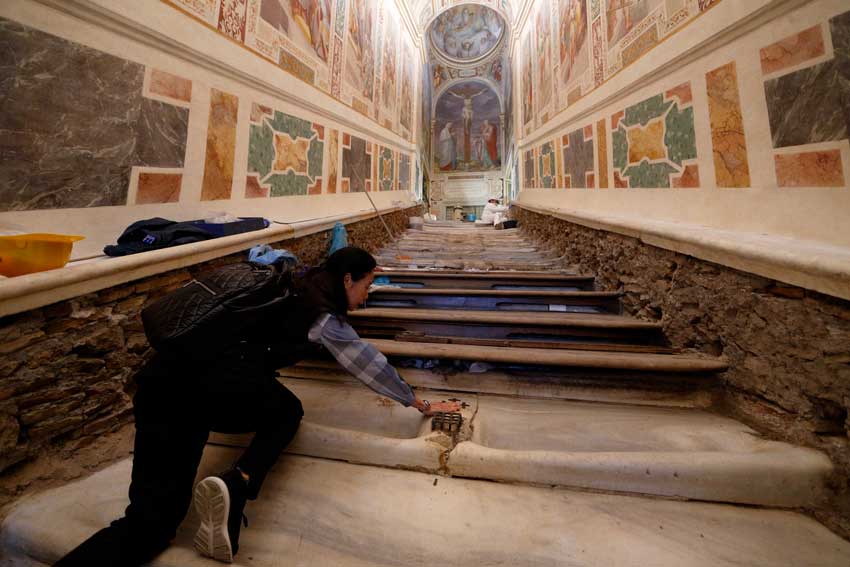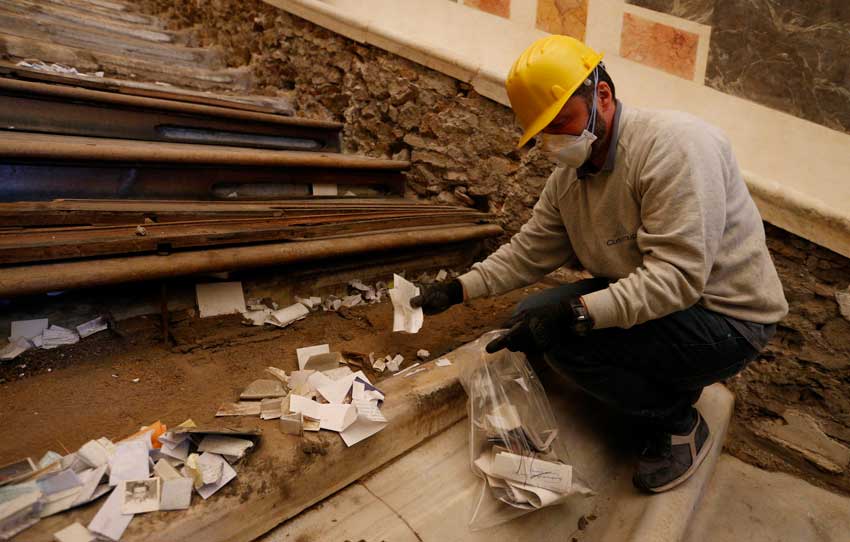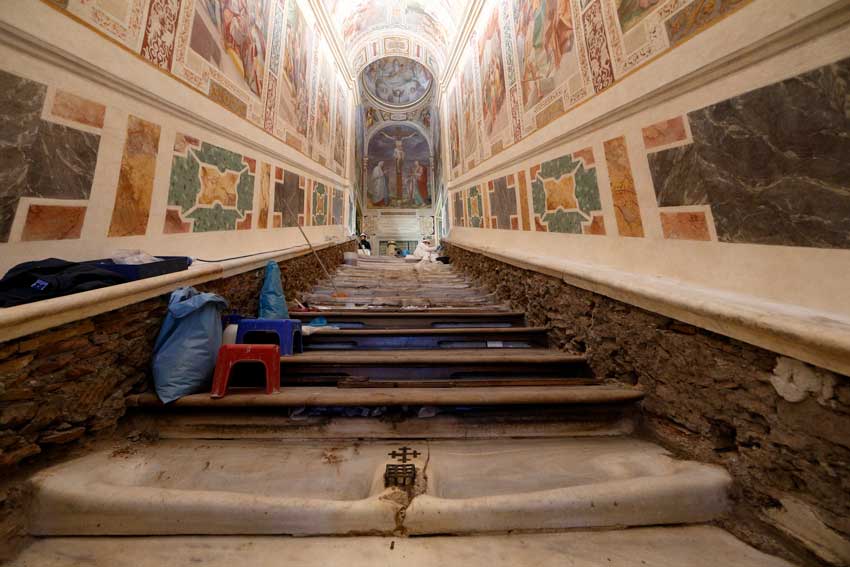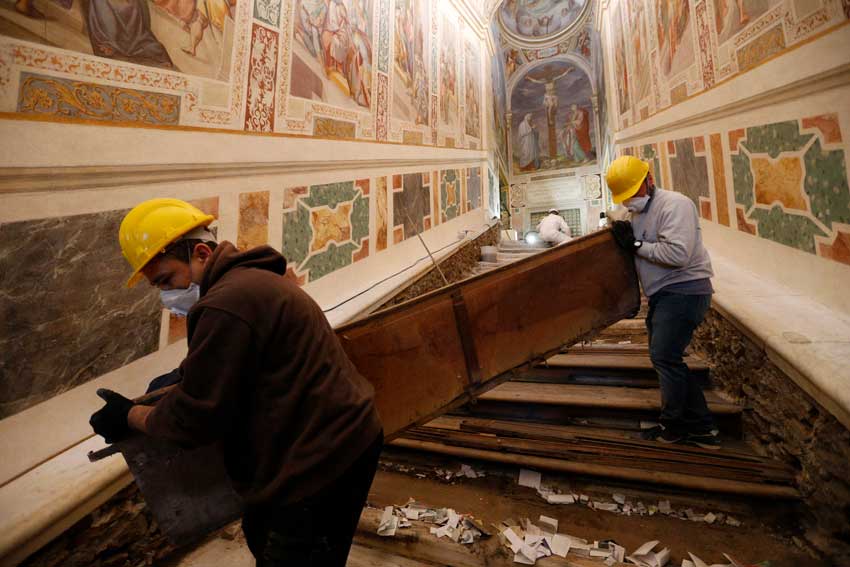
For the first time in 300 years, the marble steps of the Holy Stairs will be free from the thick wooden panels installed in 1723 to protect the stairs and left uncovered for the public.
For at least 40 days, people will be able to touch and climb the bare stones that, according to tradition, are the ones Jesus climbed when Pontius Pilate brought him before the crowd and handed him over to be crucified.
The soon-to-be cleaned steps and newly restored frescoed stairway will be unveiled April 11, the week before Holy Week, during a special blessing ceremony at the Sanctuary of the Holy Stairs. The marble steps were going to be left open to the public temporarily before the original and restored wooden panels would be put back on.
The decision was made during one of the final phases of the sanctuary’s restoration — a 20-year-long project overseen by the Vatican Museums and funded with the help of private donors, foundations and the Patrons of the Arts in the Vatican Museums.
Paolo Violini, the Vatican Museums’ head fresco restorer, and his team were so astonished and moved when they saw the degree to which the stone steps had been worn away, he felt this hidden testimony of faith had to be seen and experienced — even just temporarily — by today’s faithful.
“It’s an extraordinary occasion to touch the same steps as Jesus and witness the faith of all the other people who came before us,” the sanctuary’s rector, Passionist Father Francesco Guerra, told Catholic News Service 15.
“And it is a concrete way to become linked with those who came before us in history and the faith, who passed on the faith to us,” he said.

Tradition holds that St Helen, mother of the Emperor Constantine, brought the stairs to Rome from Jerusalem in 326 AD.
The sanctuary, whose walls and ceilings are covered with newly restored decorative paintings and frescoes depicting Christ’s passion and events of the Old Testament, was built specifically for the stairs to be venerated by the public in the late 1580s, by order of Pope Sixtus V.
Since then, millions of people climbed the steps on their knees, slowly and unintentionally digging deep undulating ruts and furrows into the soft stone. One of the 28 steps was so worn away by people’s shoe tips, a hole had been bored straight through the thick slab of stone.
That happened, Violini said, because that was the step where pilgrims lingered longer, to lean down and kiss “the most important step” above, which is cracked down the middle and adorned with a metal cross and a raised metal grate. According to tradition, Jesus fell at the 11th step, cracking it with his knee. The cross marks the point of impact, Violini said, and the open grate covers what was said to have been a spatter of his blood.

A worker stuck his finger through the grate to scoop out some debris and show just how much stone had been rubbed away by centuries of people touching the spot. A cross also marks another step at the top of the staircase, indicating where, tradition said, had been another drop of blood.
Up until now, people had only been able to see — not touch — these areas through small glass panels in the wooden treads.
A few steps were still being uncovered March 15. Two workers chipped away some pieces of brick along the staircase walls to free the rusty metal hooks securing the 300-year-old walnut wood treads in place.
Handwritten notes, holy cards, colored photographs, small coins, buttons and mounds of black dust spilled out from under the heavy plank, which was peppered with woodworm holes and stuck with wisps of spider silk.

Workers carefully bagged the written prayer requests and mementos, which had been stuck into the open slats in the stair risers. They were to be given to the Passionist Fathers in charge of the sanctuary for cataloging and study. The objects date back to no earlier than the 1950s, Violini said, which has led the restorers to believe the stairs had probably been cleaned for the Jubilee Year of 1950.
Mei Wen, a member of the Vatican Museums’ Patrons of the Arts, came from her home in Perth, Australia, to see the steps being revealed.
She told CNS she became a major donor to the stairs’ restoration after she and her husband first climbed them in 2013.
“That year what we prayed for and reflected on sort of came true so, because of that, I made a commitment that I should donate to the restoration of this project, for the faithful who want to climb the stairs for whatever reasons, for spiritual or family reasons,” she said.
Restoring such “a special place”, she said, “is also for the art and the history of it”.
She said she was moved by seeing and touching the mementos and grooves in the marble “made by people climbing on their knees. It’s very real and it’s history made centuries ago, how could you not feel something?”
